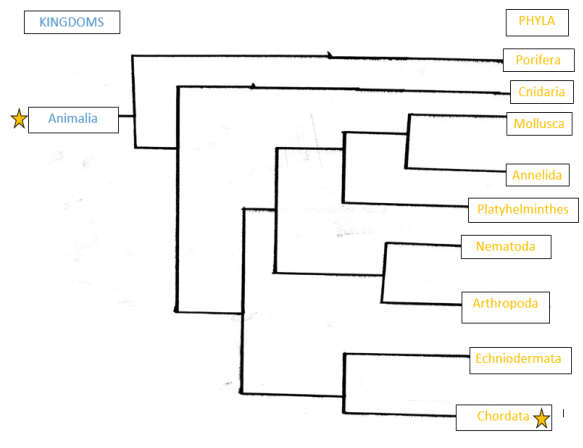Classification
Domain: Eukarya
Kingdom: Animalia
Subkingdom: Bilateria
Phylum: Chordata
Subphylum: Vertebrata
Class: Cephalaspidomorphi
Order: Petromyzontiformes
Family: Petromyzontidae
Genus: Ichthymyzon
Species: unicuspis
Domain: Eukarya
Species classified into the domain Eukarya are most
commonly known for having a nucleus. The cells of eukaryotes also have
organelles contained within a membrane such as the chloroplasts and
mitochondria (Campbell & Reece 2008). However as most of us know, not
all eukaryotes contain chloroplasts. Eukaryotic species may be unicellular
or multicellular. Because the classification system of a domain is large, a
wide variety of species fit into the classification.
Kingdom: Animalia
Species classified within the kingdom Animalia are
eukaryotic, multicellular, heterotrophic, motile at some stage, and lack
structural cell walls (Campbell & Reece 2008). Animals are
multicellular and this separates the animals from the choanoflagellates,
their sister kingdom.
Subkingdom: Bilateria
Animalia can have three different forms of symmetry
such as: asymmetry, radial symmetry, and bilateral symmetry (Campbell &
Reece 2008). The Ichthyomyzon unicuspis has bilateral symmetry,
placing the species into the subkingdom Bilateria. Bilateral symmetry
involves a single plane causing the species to face their environment in one
direction (Campbell & Reece 2008).
Phylum: Chordata
All species classified into the phylum Chordata contain
a notochord during the embryonic stage. The prefix “noto” means back and
“chord” means string, implying that the notochord runs along the back of the
species. Chordates may keep this notochord during adulthood or lose it.
Chordates also have pharyngeal slits with "pharynx" meaning throat (UC
Clermont College Biology 2014). These slits originally served the purpose
of filtering water but they have evolved on animals such as the gills of
fish
or the ears of humans (UC Clermont College Biology 2014). Chordates also
have a post anal tail; "post" means behind and "anal" means anus (UC
Clermont College Biology 2014). This is present during the embryonic stage
which they may lose when they become a mature adult.
Subphylum: Vertebrata
Vertebrates have vertebrae, which are hard protective
structures that surround the nerve chord and protect it. Vertebrates have a
skull that protects the brain and an endoskeleton that provides support and
protection which also grows with the species (UC Clermont College Biology
2014).
Class:
Cephalaspidomorphi
The class
Cephalaspidomorphi refers to jawless species that appear similar to a fish
(Encyclopedia.com 1999).
Order:
Petromyzontiformes
The order
Petromyzontiformes are known to be jawless, like stated above, but also
have jarred teeth.
Family:
Petromyzontidae
The family Petromyzontidae consist of species that have
an eel-like physical appearance. All Petromyzontidaes have seven
pairs of gills that are circular and feed on the blood of fish (Merriam
Webster Online Dictionary 2014).
Genus: Ichthyomyzon
Ichthys means fish in Greek as “myzo” means to suckle
(Froese & Pauly 2011). Therefore, species classified in the genus
Ichthyomyzon are parasitic fish-like creatures that get their nutrients from
sucking on their hosts.
Species: Ichthyomyzon unicuspis
Ichthyomyzon unicuspis means sucker fish that
has single cusps of circumoral teeth (Froese & Pauly 2011).

Figure 1. Phylogenetic tree displaying the three major kingdoms and the seven major clades of species.
Ichthyomyzon unicuspis belongs to the kingdom Eukarya (yellow star) because the cells have a nucleus and membrane bound organelles such as the mitochondria.
If you are interested in learning about other organisms belonging to the major kingdom, Eukarya, check out the following links: The Sceliphron caementarium, Tabanus longiglossus, and Chauliodes pectinicornis (summer fishfly).
The Ichthyomyzon unicuspis also belongs to the major clade, Opisthokonta (yellow star). Opisthokonta includes the kingdoms Fungi, Choanoflagellates, and Animals.

Figure 2. Phylogenetic tree displaying the nine phyla of the kingdom, Animalia.
Pictured above you can see that Ichthyomyzon unicuspis belongs to the kingdom Animalia. The kingdom Animalia has nine phyla, which are Porifera, Cnidaria (Ritteri anemone and Eurlia aurita or the common jellyfish), Mollusca (Allogona profunda or the land snail), Annelida, Platyhelminthes, Nematoda (Dirofilaria immitis or the heart worm), Arthropoda (Glossosoma intermedium), Echinodermata, and Chordata (Pimephales promelas or the flathead minnow and Bos taurus or the cow). Ichthyomyzon unicuspis belongs to the phylum Chordata (yellow star) because they possess a notochord during their embryonic stage that runs along their backs.
If you aren't familiar with the nine phyla of the kingdom Animalia, we strongly encourage you to check out the websites hyperlinked above. Each website focuses on one of the species belonging to one of the nine phyla.
To find additional information, check out the habitat page.
.jpg)